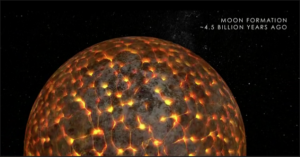
The early Moon likely contained significant volumes of water mixed into its global ocean of molten rock, theorize scientists from VU Amsterdam.
According to the conventional view, the Moon was formed by a collision of a small planetary-sized body with the young Earth that created a swirling mass of debris from which the Earth and the Moon condensed. In a process parallel to Earth’s, the Moon started as a mass of molten rock that slowly cooled over the ages. As it cooled, different minerals solidified at different temperatures and depths.
The Dutch scientists began asking how various mineral mixes behaved under extreme temperatures and pressures. Their models indicate that the Moon must have started with water mixed with the magma. Explains Ars Technica:
“How do you model an entire ocean of molten rock? You start with the known composition of the Moon and use that to create a mix of the appropriate minerals. Then you expose those minerals to extreme pressures and temperatures well beyond the melting point of rock. For these experiments, the temperatures ranged up to 1,550 degrees Celsius. Since the magma ocean was potentially hundreds of kilometers deep (current estimates range from 400 to 1,000 kilometers), pressures ranged up to 3 GigaPascals, which is nearly 30,000 atmospheres.”
The results showed a series of concentric shells with different mineral compositions. Minerals may float or sink in the magma ocean once they start forming.
But the scientists encountered a problem. Their calculations produced a crust that was 70 kilometers thick. However, rhe recent GRAIL mission to the Moon showed that the crust varies between 34 and 43 kilometers, barely half as thick. Incorporating recent data indicating that the Moon has more water than thought several years ago, the researchers conducted a second set of experiments in which minerals were allowed to bind with water before they were sealed up and melted.
They found that the presence of water as minute as 1.5 parts per thousand was sufficient to change the crust thickness. Says Ars Technica: “The authors find that several different conditions can produce the right thickness of crust: different amounts of water, different original depth of the magma ocean, and so on. But all of these conditions involve a significant amount of water in the magma ocean.”
